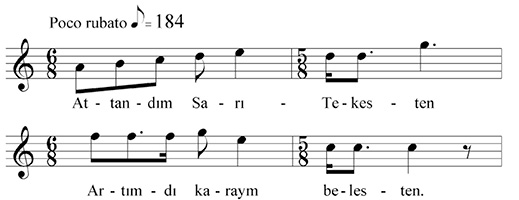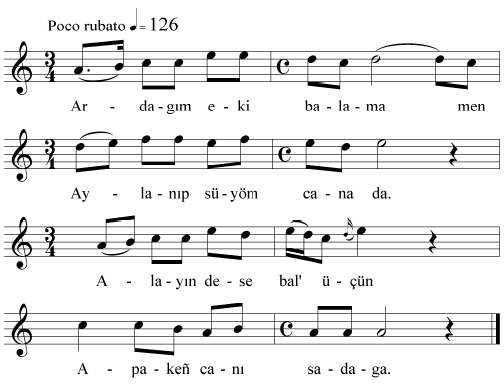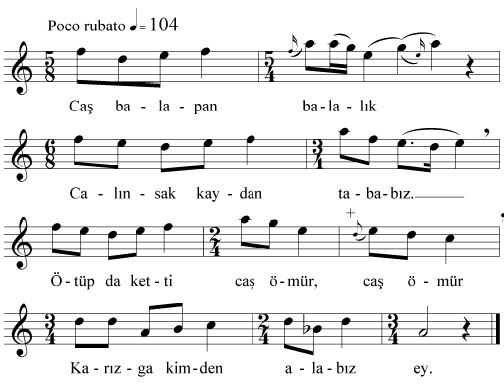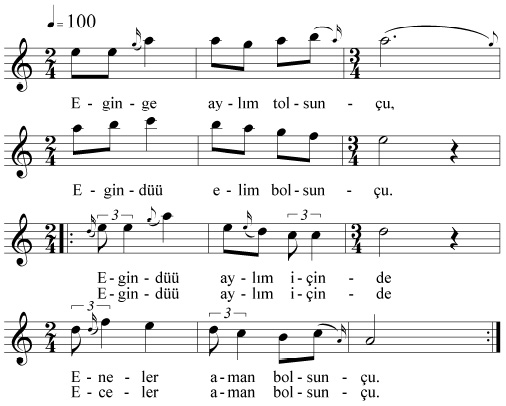- 1. Twin-bar tunes (ex.1-11, №1-58)
- Twin-bar tunes based on the g,-c bichord
- Twin-bar tunes based on rotating motifs
- Twin-bar tunes with descending/hill-shaped lines
- Motifs with a downward leap at the end of the line
- Motivic processes
- 2. Tunes moving on Ionian scales (ex.12-24, №59-164))
- Laments and their relatives
- Two-lined tunes of Major character with higher main cadences and their four-lined relatives
- Four-lined tunes of Major character
- 3. Aeolian tunes (ex.25-36, №165-238)
- Laments and related tunes
- Aeolian tunes with higher main cadence
- Four-lined tunes of Minor character
- Valley-shaped, ascending or undulating first line
- 4. Caramazan religious tunes (ex.37-41, №239-326)
- 5. Tunes of domed structure (ex.42-43, №327-332)
3.3. Four-lined tunes of Minor character (ex.30-33, №205-223)
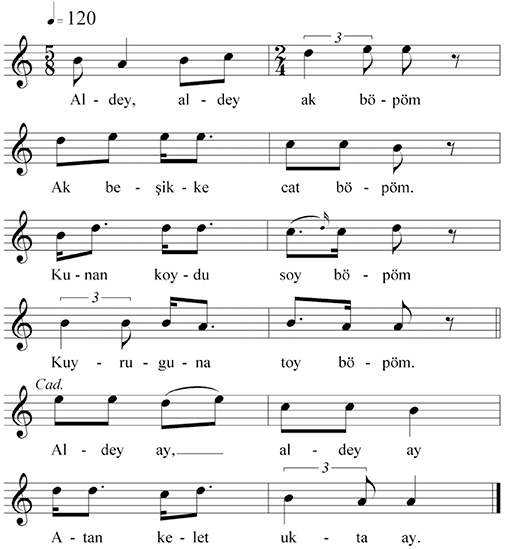


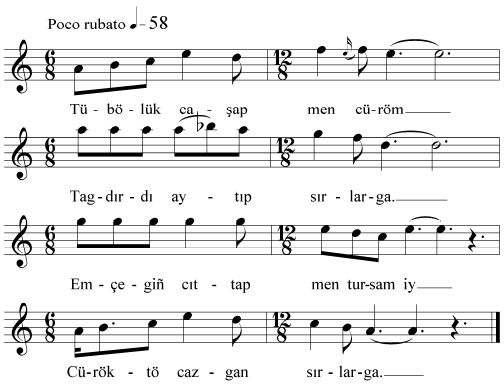


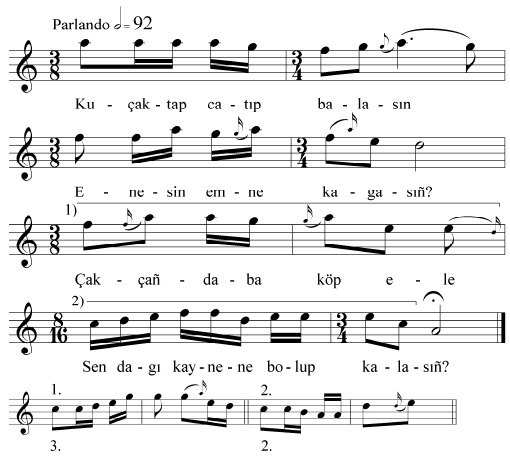


With a few exceptions I arranged these tunes by their cadential sequences. They typically begin with a recitation, or with a hill-form, sometimes with a rise. The tunes with undulation in the first line also touching on the keynote will constitute another class.
3.3.1. Tunes with 5(2)x or 5/7(b3)x cadences (ex.30a-b, №205-207). The first half of tunes with (2) main cadence tally with the two-core Phrygian tunes; the relationship between the two groups is confirmed by the genre of lullaby in several cases (ex.30a, №205-206). Those with the (b3) main cadence resemble in some way the “psalmodic” tunes of sporadic presence in Kyrgyz folk music (ex.30b, №207). I put unique №204 here for its main cadence on the 2nd degree and for being practically identical with №205, barring the end of the first line.
a)

3.3.2. Tunes with 4(5)x cadences (ex.31, №208-211). Their second line cadence higher than the first. Some melody outlines are reminiscent of Karachay tunes of similar cadences. I also ranged №208 of (6) main cadence here.
3.3.3. Tunes with 4(4)x, 5(4)x and 5/6(5/6)x cadences (ex.32a-b, №212-218). They are mainly descending. Few have 4/5(4)x cadences (ex.32a, №212-214), more have 5/6(5/6)x cadences, the latter typically in AABC form (ex.32b, №215-218). Some of the tunes ranged here have their line-ending notes secondarily modified to the 6th, rarely to the 8th degree. The cadential note of the third line is often b3.
a)

3.3.4. Tunes with 7/8(5/4)x cadences (ex.33a-b, №219-223). As the cadences suggest, the majority of these tunes have their first three lines moving high and sometimes, mainly in more recent tunes, the disjunct and even the fifth-shifting structures also appear.
a)

1 ex.30a, Lullaby, Cunuşaliyeva Toktorcan (1922, Kök Arık), Kaynazar, Aral, 2004; ex.30b, Love song (Seketbay), Abdıldayev Şükür (1933, Barskoon), Buğu-Bapa, Barskoon yayla, 2002
2 ex.31, Mother’s good wishes to her children, Işenkan (61), 1999, Suusamır, Çüy, coll. of
D. Somfai Kara
3 ex.32a, Painful song (Arman), Aydarov Usup (1947, China), Buğu-Bapa, Barskoon, 2002; ex.32b, Song of young people, Orozaliyeva Gulnar (1930, Terek-Suu), Çerik, Terek, 2004
4 ex.33a, Song to her daughter-in-law, Şabdanaliyeva Kakın (1927), Sarıbağış, Kara-Buluñ, 2004; ex.33b, Feast song, Kocokanova Baktıgül (1960, Barskoon), Barskoon, yayla, 2002

